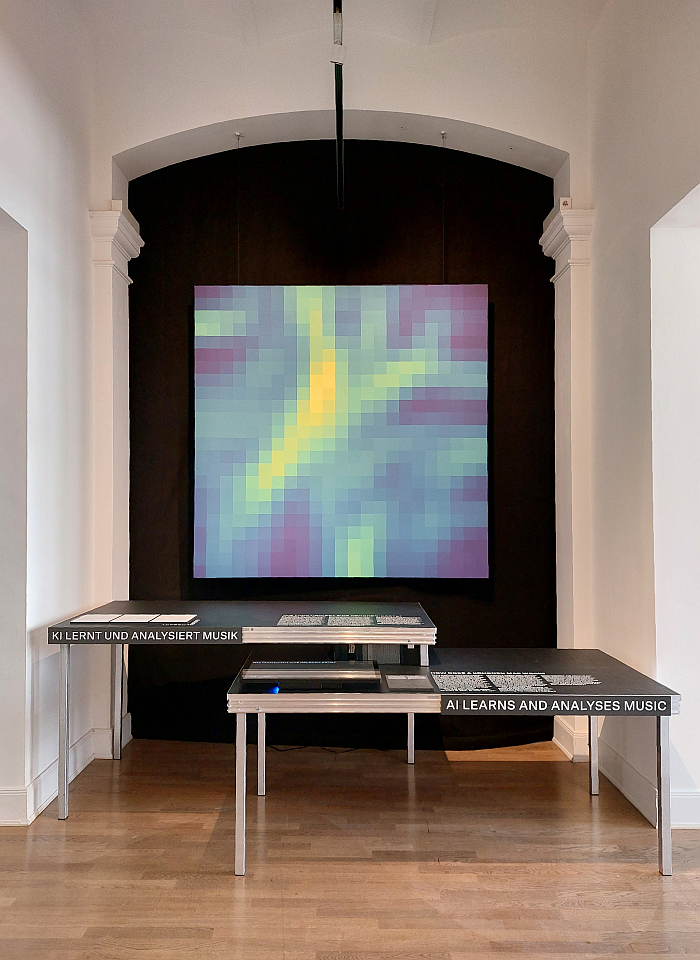Can You Hear It? Music and Artificial Intelligence at the Museum für Kunst und Gewerbe, Hamburg
Music was my first love, And it will be my last,
Music of the future. And music of the past.
confided to us all the English singer John Miles in 1976, and thereby both tending to confirm the fundamental place music has, has had, in human civilisations and societies, music as an ancient and eternal force in human civilisation and society, and also through setting the future before the past, a setting, yes, not unrelated to the requirements and provisions of the ancient laws of rhyme, most poetically reminding us all that that which is before us will one day, via processes we don’t understand yet seek to control, be behind us.
And thereby also reminding us all that the music of the future is every bit a component of a contemporary society as is the music of the past.
With the exhibtion Can You Hear It? Music and Artificial Intelligence the Museum für Kunst und Gewerbe, Hamburg, offer space for reflections on music, and musicians, past, future and present.
And by extrapolation for reflections on design past, future and present…….
Based around research by Professor Rolf Bader and his team at Hamburg University’s Institute of Systematic Musicology Can You Hear It? Music and Artificial Intelligence presents its narrative in 11 succinct chapters, 11 succinct movements, which explore and discuss Artificial Intelligence, AI, and music in context of both the technical background, the whats and hows of AI, and also the (possible) applications of AI in context of music, the wherefores of AI, including, for example, AI as a tool for the analysis and classification of music, as a tool in the composition of music or as a music instrument maker/restorer’s tool.
Wherefores that are also whys. And whos.
Whys and whos that aren’t actually present in Can You Hear It? but rather are what the viewer brings to the showcase. Or certainly should bring.
Not least because Can You Hear It? doesn’t question the validity, far less the sense, of the presented wherefores. And wherever the reverse side of a wherefore, or an argument, isn’t presented, its imperative that we add it ourselves. Which isn’t to disagree with the position presented, is but to check its validity. That thing that used to happen before everyone started shouting at each other on social media by way of validating their personal perspective on the truth.
Why, for example, do we need AI based music generation systems?
???
Who needs AI based music generation systems?
???
Can You Hear It? places its answer very much with human composers using AI, using the suggestions of AI based systems, as a writing partner, much like Benny from ABBA was to Björn from ABBA, and Björn from ABBA was to Benny from ABBA. The argument being, if we’ve understood it correctly, that AI’s ability to make more suggestions in a shorter time than Benny or Björn could, including making a great many suggestions that, arguably, neither Benny or Björn would ever conceivably arrive at, helping Benny and/or Björn in their songwriting. And while Benny and/or Björn may find that an interesting proposal, while Benny and/or Björn may say to AI, Thank you for the music……. Apologies, sorry, that was genuinely awful, it won’t happen again……. while Benny and/or Björn may find that an interesting proposal, it clearly isn’t in itself an irrefutable argument, or even a convincing argument, for AI. Benny and Björn did OK without AI. As did Elton and Bernie, Burt and Hal, Neil and Chris, Mike, Matt and Pete, and a great many other song writing partnerships.
AI can however also generate complete pieces of music, which may or may not be the same as composing complete pieces music, that’s a philosophical discussion for another day, a generation of music that can have numerous purposes. On the one hand, as anyone who has ever had to produce, on a non-existent budget, a film or photomontage to be publicly aired, 🙋, can confirm, finding a piece of appropriate license free background music for your zero-budget film/photomontage can take longer than producing the film/photomontage. Then there are the innumerable pieces of music required as an audio backdrop for the contemporary flood of computer games, be that the high profile ones for gaming systems or the free ones for your phone, and a flood of games that shows no sign of receding in the immediate future, indeed seems to be getting more intense; licensing actual music from actual musicians for computer games is expensive, which is arguably one of the reasons so many high profile games promote their soundtracks, seeking as they do to get some free PR from the money they’ve spent licensing the tunes. Similarly licensing music for advertising or for ambient background music in shops or for telephone holding patterns or for the innumerable streaming series that define contemporary television, or that which was once known as television, is an expensive undertaking. Or licensing music for a cash-strapped theatre production.
Alternatively you can ask an AI powered music platform to generate that appropriate piece.
An AI powered music platform you can also ask to generate a song that sounds a bit like Taylor Swift. And which you can then sell.
Questions posed of AI powered music generators that remind that much, ¿all?, AI generated music is essentially variations on existing tunes: a learning of existing tunes and then suggesting new tunes based on those tunes it has learned, which is also one of those contemporary legal grey areas that is going to keep orchestras of lawyers busy for almost as long as Donald Trump is.
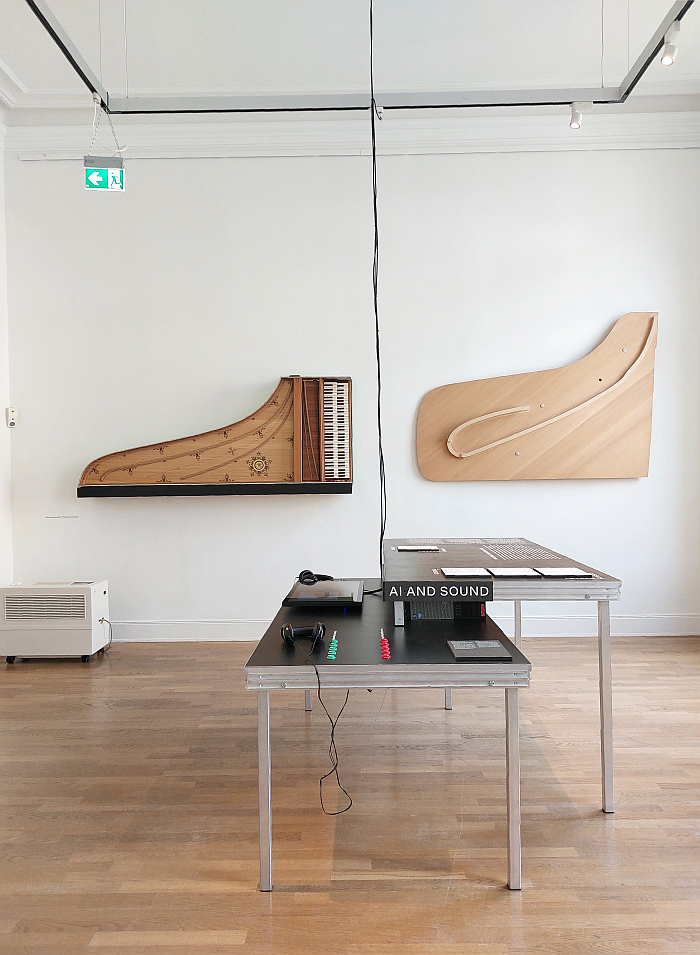
A discussion on sound, AI & music, as seen at Can You Hear It? Music and Artificial Intelligence, Museum für Kunst und Gewerbe, Hamburg
And questions posed of AI powered music generators, and by music industry and AI industry lawyers, that very naturally leads you to reflect on the (hi)story of music and the question of in how far that (hi)story for all it is unquestionably one of human creativity, inventiveness and fantasy, is also one of what has come before influencing and informing what comes later, the music of the past informing and influencing the music of the future before that itself becomes the informative and influential music of the past: sometimes an abstract influence and informing, sometimes a more direct. An abstract influencing and informing that reminds us that music, as with art, architecture, literature, design is a continuum, is dependent on all that has come before, be that as something to imitate/re-imagine or something to resist/attack, and both by way of creating something original and novel that moves things on in context of the respective creative’s reaction to contemporary realities; and a more direct influencing and informing that is of a much less altruistic character. Whereby, and as discussed in context of the plagiarism trial concerning Pharrell Williams and Robin Thicke’s Blurred Lines and its similarity to Marvin Gaye’s Got to Give It Up, it is important to note that it is but a very, very fine line between inspiration/homage and plagiarism. Arguably it comes down more to the intention, and the development process, than the end result.
Thoughts on inspiration/homage/plagiarism, and on the validity of an AI generated song that sounds a bit like Taylor Swift, which lead one to question if music hasn’t always been about musicians trying to sound a bit like one another? Or more accurately, in recent centuries has the music industry not been primarily concerned with finding musicians/songs who sound like popular, successful, musicians/songs? Is an AI generated song that sounds a bit like Taylor Swift any worse than a song written by a human with the aim of creating something that sounds a bit like Taylor Swift? Is it not at least more honest in that it is open about what it is doing? And if you’re not Taylor Swift, why would you want a song that sounded a bit like Taylor Swift? If you’re not Coldplay, Blur, Beyoncé, Madonna, Chic, Frankie Valli, The Beatles, Chuck Berry et al why would you want a song that sounded a bit like them? If you’re not Verner Panton, Ettore Sottass, Gae Aulenti, Charlotte Perriand, Gertrud Kleinhempel, Charles Rennie Macintosh, Michael Thonet, et al why would you want a chair that looked a bit like theirs? Why not a song, or a chair, a lamp, a telephone, a vase, that sounds, looks, functions, like you and your response to contemporary social, political, economic et al realities?
Thoughts which bring one back to the aforementioned Mike, Matt & Pete, more popularly known as Stock, Aitken & Waterman, and who in the 1980s turned out songs on a near industrial scale which, when not all sounding exactly the same — a Hazel Dean not being exactly a Mel and Kim not being exactly a Kylie Minogue not being exactly a Rick Astley — were based on an essentially formulaic approach to song generation, an analysis of and position on what is likely to be commercially successful and moving forward from that point, with the aim of achieving that commercial success.1 Something that, we’d argue, can be gleaned with the ease I should be lucky and Never gonna give you up can be segued in and out of one-another. A near industrial output of music by Stock, Aitken & Waterman, an essentially formulaic approach to song generation — which by the way isn’t a criticism, far, far, from it, just an observation — that can also be found, for example, in the work of a Jim Steinman: a Two Out of Three Ain’t Bad isn’t a Holding out for a Hero isn’t a More, but, kinda is… Or in the work of a Dieter Bohlen. Or in the output of the late 19th century Thonet factory in Koryčany, Czech Republic. Or in the Tyrolean Volksmusik community. Or in K-Pop. Which again is observation not criticism.
Which all reminds us, as does Can You Hear It?, that music, as with literature or art, has, to evoke a Max Borka, a commercial component and a cultural component, is a symbiosis of a commercial and cultural aspect, or at least has been since commercialism began to rear its head in the late Middle Ages, disrupting as it rose the established methods of distributing and developing cultural goods; music, literature, art were once consumed culturally (and representatively 2), by limited groups of advantaged individuals, but are now consumed culturally and commercially (and representatively) by mass society. Which again isn’t a criticism. Honest! It’s not!!! And a symbiotic relationship that, arguably, has until now been essentially a commensalistic relationship, the commercial component profiting while the cultural remains unaffected; but a relationship which through the increasing hunger of the commercial aspect, and the increasing commercial pressure to maximise the monetisation of the culture aspect, runs the risk of slipping into the parasitic, the commercial living off the cultural and damaging it as it does so. A reality that also exists in design: those objects you buy in a shop aren’t always cultural artefacts but very often a commercial monetisation of a cultural impulse, regularly, and increasingly so, a historical impulse or alternatively, and increasingly so, objects with absolutely no cultural connection or value but rather products deliberately created to imply a particular cultural link, or to look a bit like Taylor Swift. And openly commercial objects which are increasingly becoming ever more dominant over the cultural impulse they require for their existence. An increasing commercialisation of design, and music, and literature and art, an increasing shift from commensalism to parasitism that Can You Hear It? very much implies AI could fundamentally advance.
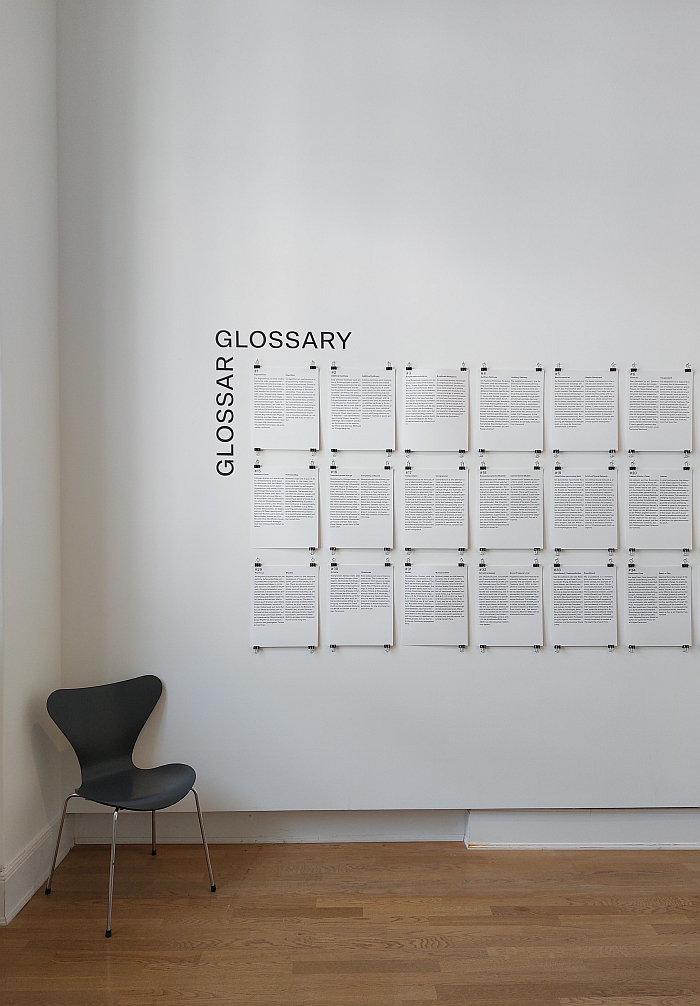
A music and AI glossary, as seen at Can You Hear It? Music and Artificial Intelligence, Museum für Kunst und Gewerbe, Hamburg
Related to thoughts of the history of music as one of musicians trying to sound like one another, is the thoughts enabled in and by Can You Hear It? on the maintenance of certain standards as a key component of regional vernacular music; of music based on recurring structures, scales, tempos, motifs etc, as the basis for the maintenance of regional vernacular forms of music. Or more contemporary forms of music, bands like the Ramones or Scooter or the programmatically monickered Status Quo making careers out of sounding (more or less) the same from album to album to album. Similarly the long-standing ubiquity of the tweed tartans of Scotland.
A maintenance that is important for the associations of identity reinforced by the music, be that regional vernacular or surf garage; but a maintenance of certain standards as a key component of regional vernacular music, and regional textiles, and furniture from Scandinavia, that for all that there is nothing intrinsically to find fault in it and often much to delight in, also is, or can be, for all when dogmatically, and/or commercially, applied, a block on the development of that music, or furniture, can stop it from being responsive, can stop it from evolving as the realities around it evolve, can keep it in a time long gone rather than one being faced. With all the consequences that invariably brings with it. The aforementioned Thonet’s move from 19th century bent tubular beech to 20th century bent tubular steel neatly underscoring why, regardless of past associations, or past successes, or of the unparalleled joy of past creations, one should, must, continually re-imagine the old in the new contexts it finds itself, as does the approach to tweed of a Bernat Klein, as does Poison Heart, as do the teachings of a Kaare Klint, as do Asian Dub Foundation, as does a Stuart Adamson or a Malcolm Jones teaching their guitars to skirl like the pipes. Pipes, for all tartan cloaked pipes, that remind that maintenance of structures, scales, tempos, motifs etc, or tartans, chairs, tableware, can also perpetuate myths about the (hi)story and traditions of the communities a vernacular claim’s to represent and thereby reinforce skews in appreciations of the path taken to today with all the inevitable consequences that has for (the possibilities for) the future development of that society. You can’t build on skewed foundations. Not even if you live in Pisa. But you can earn money with those skewed foundations. Just ask the Scottish tartan industry.
Thoughts on regional vernacular, symbiosis, Taylor Swift, Ramones, Pisa, tartan and tradition that flow very neatly into Can You Hear It?‘s chapters on AI and the analysis of music.
And the whys and whos of an AI supported analysis of music.

The Dance Booth, as seen at Can You Hear It? Music and Artificial Intelligence, Museum für Kunst und Gewerbe, Hamburg
An AI supported analysis of music approached in Can You Hear It? primarily from two perspectives.
Staying very much in the commercial arena is the discussion on an AI supported analysis of music as the basis for algorithms making suggestions for other music you might like, that musical manifestation of classification and organisation as an enabler of a commercial exploitation of natural and cultural goods, and which in doing so tends to replace an intuitive, inquisitive, responsive, relationship with a predefined, static consumption. That application of AI that means an AI generated song that sounds a bit like Taylor Swift is likely to be commercially successful on a streaming service which employs AI to analyse tunes and suggest songs that sound a bit like Taylor Swift to anyone who regularly listens to Taylor Swift, or to songs that sound a bit like Taylor Swift. Leading to a perpetuation of AI generated songs that sound a bit like Taylor Swift. With all the cultural consequences that has. And that purely for commercial gain. Thereby underscoring the oft overlooked relevance of the interplay of numerous AI applications as we move forward, and thus reminding us all that the (hi)story of human civilisation is one of us all not understanding interplays. Often not seeing interplays till it’s way too late.
And staying in the cultural arena, and for all in context of regional vernacular music, is the discussion on AI supported analysis of music and…….. ethnology. No, really. Ethnology.
Why is ethnology still a thing in 2023? Have we not all long since learned that our best hope of making it to the 22nd century is to stop focussing on, obsessing over, what makes us different, stop trying to define cultural and social and tribal affiliation in the minutest possible detail by way of a self-indulgent academic pigeon-holing, and start concentrating on those things that unite us?3 And that not least against the background of the ease and delight with which rapidly developing, and increasingly autonomously so, AI systems adopt and reinforce the prejudices, biases and racisms of humans. Do we not have a responsibility to future generations to keep AI away from that eternal human fault, much as we must keep AI away from the horrors of the human ego. And does music not teach us, arguably better than any other medium, that classification, pigeon-holing, delineating on the basis of perceived, and invariably transient and volatile and fuzzy, characteristics is as meaningless as it is counter productive and (often) toxic. If it’s good it’s good, if it’s bad it’s bad, whether a tune or a chair or a person or a group of individuals.4 What is ‘Scandinavian Design’? Really? Honestly? Why is ‘Scandinavian Design’? Who is ‘Scandinavian Design’?
And why do all European ethnologists invariably focus on Indonesia or Polynesia or Micronesia or et al? Why does it always have to be island peoples far away from Europe? We get the ‘communities developing in isolation’ thing of Darwin’s finches, but is there no geographically disconnected music in Europe of interest, in need of an in-depth analysis? Are the varied and various harps of Europe so uninteresting that one has to study ancient stringed instruments of far off islands? Is there no academic satisfaction to be found in an analysis of regional variations within Swedish melodic death metal or within London Grime or within the folk music of the Balkans? Or within the canon of Stock, Aitken & Waterman?
Why does it always have to be, for example, the Hulusi, Labium, Pat wain and other instruments that one meets in Can You Hear It? Or the Gamlan of Indonesia discussed in context of an AI supported analysis of Gamlan ensembles from different regions by way of determining differences between the ensembles of Europe and those of Indonesia, another one of those presented wherefores that is also an unspoken why and who. Why?
Unspoken whys and whos as a counterbalance to a presented wherefore that take on a particular relevance, and a particularly thought provoking character, in context of the presentation of an analysis of the music of the Uyghur, and how AI can help distinguish the music of the Uyghur from the music of, amongst others, the Kachin, the Yi, the Khmer or the Han: “it is also subject to misuse”, the curators note, “depending on the data fed into it”. Or depending on who uses the results of the analysis and why they undertake that analysis: standing in the Museum für Kunst und Gewerbe you can almost sense the Chinese police shaking with excitement at thought of an app that allows them to analyse if a particular tune is Uyghur, or to study an individual’s streaming history for evidence of a preference for Uyghur music over Han music, before dispatching the thus convicted individual to a camp to learn to navigate towards those points on the western edge of Kohonen map they have thus far avoided. Camps that have been and are home to a great many Uyghur musicians: the Dutar hanging mute and functionless on the wall of the Museum für Kunst und Gewerbe as a classic example of a museal approximation of a cultural good also being an unnerving synonym for the fate of, amongst others, Abdurehim Heyt. And no we don’t really want an AI supported analysis of the folk music in the Balkans as the basis for delineating ethnic affiliation across that most ethnically volatile of regions. Why would we? It may be possible, but that doesn’t mean its desirable or of any conceivable value to human society. Less Can You Hear It? as Should You Do It? See also flying taxis, autonomous cars or delivery drones. Or having your groceries delivered within 10 minutes. Why? Who?
¿And the application of AI in, for and to music? ¿Given all that you’ve noted above, that fairly dark picture you’ve sketched of Commerce, Parasitism, Stagnation, Tension and their nefarious allies, that sombre march you’ve composed to accompany human society’s path forward, is the application of AI in, for and to music something that is possible but ultimately, undesirable and unhelpful?
Valid point, we understand where it’s come from, but remember, we’re testing validity, not disagreeing. And thus a question we’ll carrying with us from Can You Hear It? into the permanent exhibition of the Museum für Kunst und Gewerbe’s historic music instrument collection.
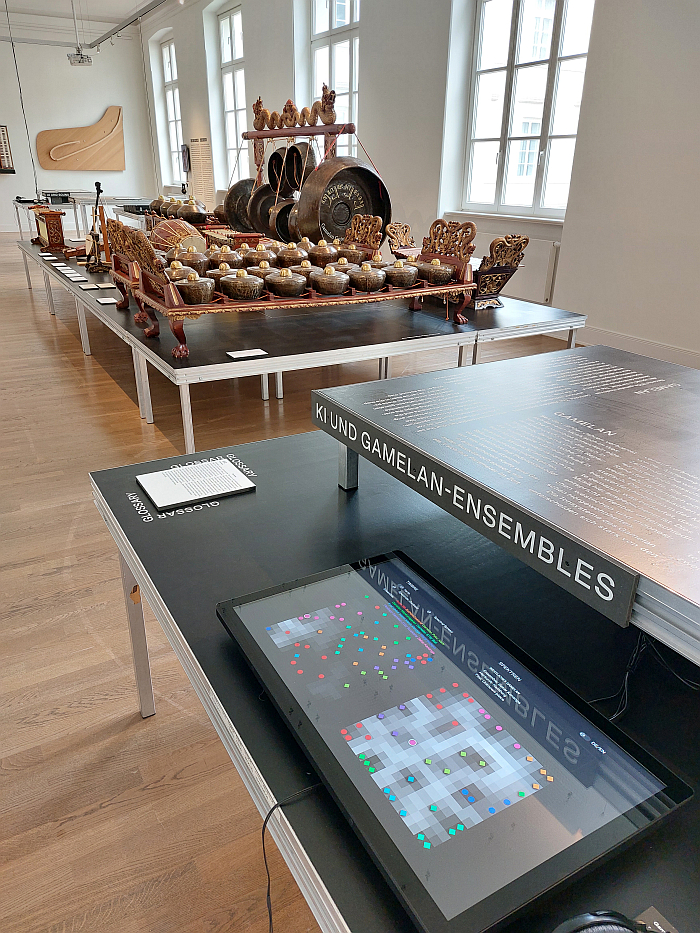
An AI powered analysis of Ganlan ensembles, and the sort of bronze gongs employed, as seen at Can You Hear It? Music and Artificial Intelligence, Museum für Kunst und Gewerbe, Hamburg
An historic music instrument collection showcase where you appreciate not only that instrument and tool are synonyms, ¡¡¡who knew!!!, but also better appreciate that for all the (hi)story of music is one of human creativity, inventiveness and fantasy, and a desire to sound like a conceived historic standard or like your last album or a commercially successful artist whose success you hope to profit from, it is also a (hi)story of ever novel technology. Novel technology that is one of the main reasons why music has developed and evolved over the centuries of human society. Novel technology arising in the ever novel realities and contexts in which a society invariably finds itself as one of the more important motors for the development of novel music. And not just technology in context of how we make music, but also how music is transmitted, reproduced, manipulated, stored, et al.
Thoughts on technology and music which lead one to thoughts of the hip hop encountered in Can You Hear It? in context of a comparison of American and Chinese hip hop — why?, who?; or more specifically leads one to thoughts of sampling, which is, if one so will a trawling of sources for sounds that can be pasted together to create a novel sound, much as, and simplifying to the point of inaccuracy, AI supported music generation platforms do. And sampling, and the legal controversies of the early days of sampling, which very much reminds of the current legal discussions around AI and music. It’s that helix again, bringing us back to a similar place in a new context.
Thoughts on technology and music which, for all in the Dance Booth encountered in Can You Hear It?, remind of a Giorgio Moroder who, as he tells the tale, was looking for “a sound of the future” and discovered it in syncing a click through a Moog modular, thereby, more or less, laying one of the primary paths to electronic dance music. And a Giorgio Moroder who through his admonishment that “once you free your mind about a concept of ‘harmony’ and of music being ‘correct’, you can do whatever you want” 5, helps signpost a possible path for contemporary musicians to the “sound of the future”. And, yes, a quote written big on our walls.
Thoughts on technology and music which remind of a Iannis Xenakis, a musician who, inarguably, would have obsessed over the possibilities of AI like no other, and who from the 1960s onwards developed several computer devices and processes and programmes to enable the automatic generation of unique pieces of music, which may or may not have been composing, including in the 1980s the so-called UNIC, an “electromagnetic table, on which we can draw with an electronic pencil … the shape drawn on the table is calculated immediately by a computer and the result can be heard within a few minutes”. Even if according to Bálint András Varga it wasn’t that straightforward. 6 New technology rarely is.
And thoughts on music and technology which take you back over the sampler, the Moog modulor, electric amplifiers, cassettes, radios, pianos, harps, and ever further backwards towards the ancient Greece that was so important in the development and creativity of a Iannis Xenakis, and to that moment when, as Le Corbusier notes in le Modular, “the first musical script was created” 7, that moment, popularly attributed to Pythagoras, but which in all probability wasn’t his work alone, or indeed the work of the Greeks alone, Pythagoras being in all probability but the most visible individual from our contemporary distance, a popularly accepted inaccurate viewing of the past that is always worth remembering…… that moment in ancient Greece when, with the aid of mathematics, music became something that could be written down and physically transmitted, a moment when, as Le Corbusier opines, infinite ever changing natural sound could be measured and sub-divided, controlled, that, arguably, earliest, example of human civilisation standardising and organising, harnessing, natural systems, natural variation, for its own benefit, that classification based on artificial systems which enabled the industrial society that we’re still so proud of and dependent on. And a use of mathematics in ancient Greece to measure, structure, delineate, partition, standardise, analyse and create sound very much akin, very much comparable with, what AI is and does and enables.
“It may well be”, Le Corbusier philosophises in le Modular in context of the various forms of musical notation, “that the apotheosis of the machine age will demand a subtler tool, capable of setting down arrangements of sounds hitherto neglected or unheard, not sensed or not liked…” 8 Is AI not that “subtler tool”? Is AI not that latest in a long line of “subtler tool”s? Is AI not the latest manifestation of a Walter Gropius’s “Art and Technology a new unity! Technology doesn’t need art, but art very much needs technology”? 9 Is AI not a tool for the music of the future much as the Pythagorean scale, the tempered scale, atonality, UNIC, sampling or syncing once were? Is AI not that which will allow music to further develop and evolve, will allow music to connect with the past while remaining relevant for future communities and societies? Is AI not but a step in an ongoing journey, a novel moment on the continuum, a further example of the use of novel technology to develop and realise and propagate sounds that until now have been “neglected or unheard, not sensed or not liked”? In 1823 the idea that the works of, for example, Prince Buster, X-ray Spex, Fields of the Nephilim, Kraftwerk, Napalm Death, O.M.D., Missy Elliot, Goldie, Fela Kuti, Black Sabbath, John Cage, Nirvana, Public Enemy, Die Ärzte, Mogwai, Joy Division, Nina Simone, etc, etc, etc could be classed as music would have been greeted with howls of laughter. And perhaps dismay. Much as Bob Dylan’s electric guitar was in 1965. Glimpses of the music of Iannis Xenakis being held up in 1823 as irrefutable evidence of the coming apocalypse, of the damnation into which humans had led human society. The music of the past, and present, that is so familiar to us was, as the music of the future, unimaginable, inconceivable, and also conceptually and technologically impossible to realise. Was, to paraphrase a Konstantin Grcic, an approaching, but intangible, New Normal. Only became tangible, comprehensible, normal, when novel technology interacted with developments and evolutions in society, when a new unity of technology and society arose.
Similarly our objects of daily use.
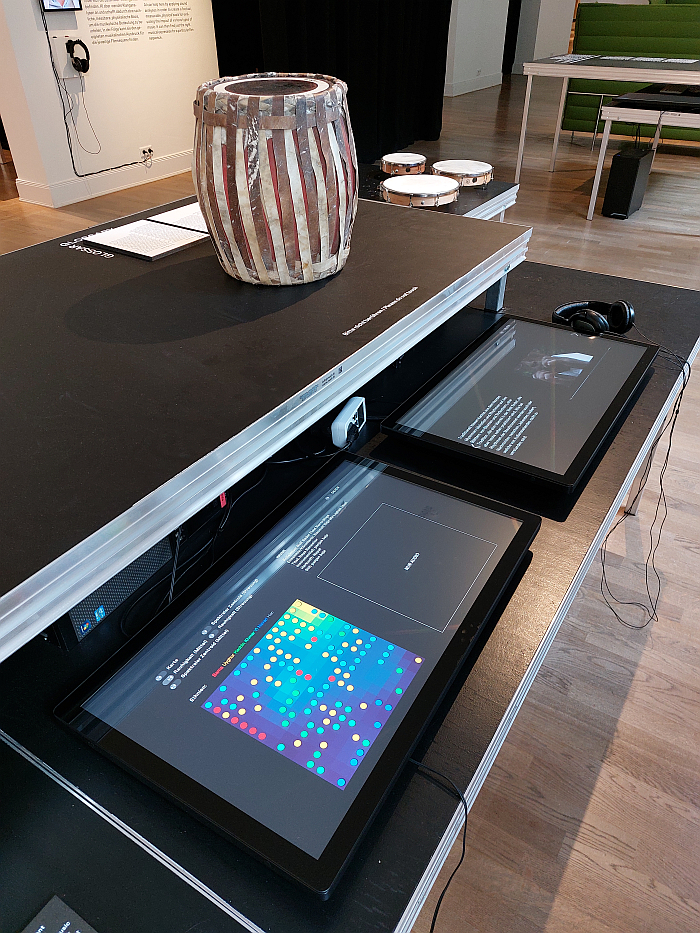
Analysing the music different ethnic groups in China, and a Pat waim drum from Myanmar, as seen at Can You Hear It? Music and Artificial Intelligence, Museum für Kunst und Gewerbe, Hamburg
Design, as that practice which brings forth those currently unimaginable, inconceivable future objects and systems and solutions, is dependent on novel technology to enable new approaches, new forms, new objects, for the new social, economic, ecological et al realities, to realise that which has been “neglected or unheard, not sensed or not liked”. But not to realise that which already exists. That lesson we’ve all learned from the stumbling arrival of industrial production in Europe in the early 20th century where, arguably, it was the clumsiness of the historic forms and objects produced with the novel machines and materials that caused such resistance, only when designers started using the novel technology to produce new objects, new forms, new functionalities were the machines accepted. A reality a Clara Porset also describes, lamenting in 1949 of a “passive resignation to the ugly industrial, that implies ignorance of the possibilities of expression through industrial production”, in the Mexico of the day, and arguing that while artisan production had to be maintained, “the industrial design of objects seen and used by everybody everyday, has to be welcomed, guided and promoted” and that “the opposite would imply remaining stuck in economic and cultural evolution, because industrial art is one of the highest and most progressive manifestations of contemporary economy and culture.”10
Similarly, we’d argue, design and AI. We can’t resign ourselves to using AI to produce unappealing approximations of what is, can’t remain “stuck in economic and cultural evolution”, but must embrace the “possibilities of expression” through AI, we must unite novel technology with novel concepts, unite artificial intelligence with human creativity, jut as human creativity has united with all new technology since, arguably, the stone age. Art and Technology a new unity! is a description of a continuum not a position fixed in 1924.
And the same with music.
As Can You Hear It? tends to imply we’re very much at the beginning of the relationship between AI and music, are still feeling our way along, and as an exhibition Can You Hear It? very much concentrates on those aspects we can all most readily grasp. As a showcase Can You Hear It?‘s focus is very much on understanding the whats and hows of AI and music, that technical witchcraft that powers AI, and for all a focus on the commercial wherefores of AI and music, if one so will, and with a nod to the showcases’s location, Kunst und Gewerbe eine neue Einheit! Art and Industry a new unity! Which, again, isn’t a complaint, far from it: on the one hand it’s a showcase based on research by Hamburg University’s Institute of Systematic Musicology, i.e. Hamburg University’s Institute of, as they state, “musical acoustics and music psychology“. Which is what is featured in Can You Hear It? The former in terms of, for example, the use of AI in instrument production and restoration, the latter in terms of, for example the aforementioned streaming algorithms, and also music as a stimulant of emotion in film, that monetisation of psychological insights of relationships with music, that monetisation of the fact that, as Benny and Björn remind us, “nothing can capture the heart like a melody can”. And on the other hand, the cultural wherefores don’t exist yet: much as designers are still learning, discovering, imagining, fantasticating what is, could be, possible with AI, so musicians. And just as you couldn’t have discussed twelve-tone in 1880, ska in 1920, hip hop in 1950, punk in 1960 or rave in 1980, nor in 2023 can you discuss AI’s contribution to the development of music. But those wherefores will come.
And will come as more than just generating untold songs that sound a bit like the music of the past, producing historic objects on contemporary machines, or untold songs that sound a bit like easy profit, that ugliness through ignorance and/or commerce, and will come as more than just generic background noise for arranging fruit on your phone or being sold an autonomous car, or just as an aid to the music industry’s contemporary addiction to re-issuing and re-mastering, and also salvaging previously unreleased material from ageing, disintegrating tapes, something that can be understood in Paul Mccartney’s use of AI to enable John Lennon to contribute to the forthcoming last Beatles album. Expect a lot more long since dead musicians to reappear in the coming years.
It will also come as the music of the future.
Or will come as the music of the future if allowed to develop freely, unhindered and unimpeded by the demands of commerce, unhindered and unimpeded by that “unmerciful censor of all ideas”, as former Vitra CEO Rolf Fehlbaum once so deliciously defined “commercial intention”.11 Will come if we remember that music is a symbiosis of culture and commerce, is dependent on both.
And so to answer your question, the application of AI and music is necessary, if as Can You Hear It? helps elucidate it is not without its flippancies and undesirabilities and traps, flippancies and undesirabilities and traps it is up to us all to be aware of and navigate.
Up to us all to question the validity of any given wherefore.
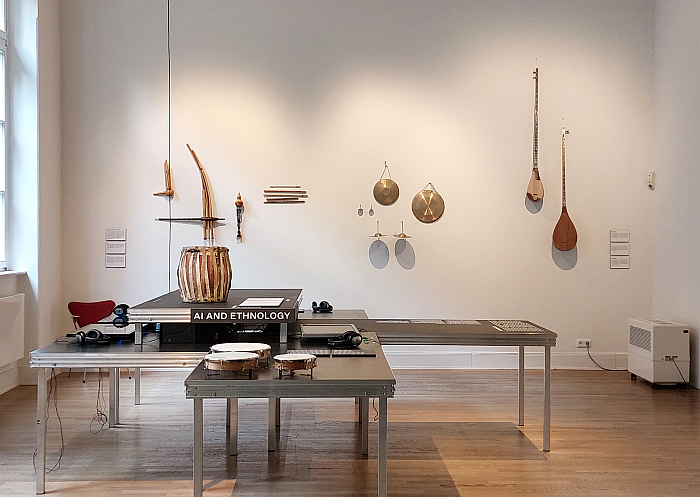
Reflections on ethnology, music & AI, as seen at Can You Hear It? Music and Artificial Intelligence, Museum für Kunst und Gewerbe, Hamburg
For all that it is an exhibtion about AI and music Can You Hear It? is also an exhibition about music and an exhibition about AI; the former through, for example, the introduction to aspects of music instrument production, tuning, functionality, and also via the inclusion of a vocabulary of some 42 terms which introduces phrases such as Dynamics, Soundboard or Register. The latter through, for example, the inclusion of phrases such as Physical Models, Connectionist Models or Artificial Neural Network in said vocabulary, the explanation of how and whats of AI, including those all so important Kohonen maps, and also through the reflections Can You Hear It? enables on AI not just in context of music but in all areas of life and society.
Reflections that allow one to better appreciate that in many regards AI is essentially just doing what we already do, just a lot faster and with less effort. And thus is but a continuation of that optimisation that has, arguably, ¿inarguably?, been one of the key driving forces in human society, certainly the European human society European ethnographers ignore, since the early decades of the 20th century; and an optimisation which, as discussed from, for example, Time, Freedom and Control – The Legacy of Johannes Bürk at the Uhrenindustriemuseum Villingen-Schwenningen, Organizing Things at the Werkbundarchiv – Museum der Dinge, Berlin, or Plant Fever. Towards a Phyto-centred design at Schloss Pillnitz, Dresden, while not intrinsically bad, can go wrong. Often very badly wrong. Certainly when humans optimise. When humans optimise with a commercial focus rather than a social. Often ends up with individuals, communities and society, and our planet, losing something of the freedom and individuality and carefreeness once considered fundamental. And tending to place us all in novel dependencies. Tends to lead to an app. Doesn’t always, but very often does. A danger, as noted above, Can You Hear It? tends to imply is very present in the utilisation of AI in context of music. And one whose presence we must be aware of. Regardless of how much it sounds as if it really could be Taylor Swift. Or perhaps because it does.
Danger also in context of the environmental impact of AI; we all know that much of the technology AI depends upon requires the sorts of metals and ores that, as discussed from Into the Deep. Mines of the Future at the Zeppelin Museum, Friedrichshafen, are not only rare but well hidden, and whose extraction and processing invariably brings with it irreparable environmental damage, and unappetising political compromise with all the long term consequences that brings with it; and thus we all understand, or should understand, the necessity of being judicious in our use of AI. Of questioning the necessity of all and any wherefore, and of honestly and objectively comparing the AI approach with the analogue alternatives. Do a Benny and/or a Björn really need AI.12 Or just a piano? Groceries in 10 minutes? Smart fridges that order food?
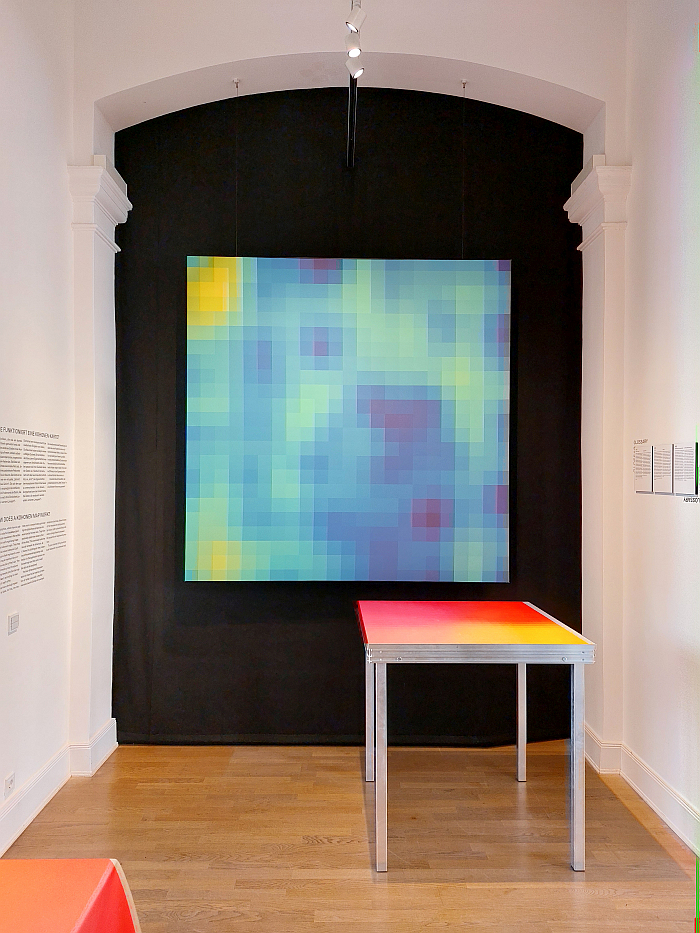
Yes, resembles the carpet by Gertrud Arndt that Walter Gropius used in his office at Bauhaus Weimar, is Kohonen map, one of the basics of AI, as seen at Can You Hear It? Music and Artificial Intelligence, Museum für Kunst und Gewerbe, Hamburg
Danger also in context of the economic impact of AI; quite aside from the untold, for want of a better phrase, non-creative jobs that AI can, or will, be able to perform much more efficiently and thus cheaper than humans, much as new technology has always led to changes, changes that come with foreseeable and unforeseeable consequences, are all the creative jobs AI will increasingly be able to perform. Which is, arguably, the novel on AI as a novel technology. If, for example, as noted above computer game producers and autonomous car advertisers start using AI generated music that means they’re not paying musicians. Don’t need musicians. And while no-one would shed that many tears if a multimillionaire musician wasn’t paid a couple of million for their tune being used on a computer game, there are an awful lot of less wealthy musicians who rely on less opulent fees to pay their ever-increasing rent. While going forward AI can, and will, more generally reduce the need for musicians: if a record label can generate an AI band whose AI generated songs sound a bit like Taylor Swift or Chic or ABBA or Mr Oizo or Phillip Boa or whoever, and who are successful on AI supported streaming services that tend towards commercial monotony, that has to be more profitable, and thus more attractive for a profit orientated record label, than working with actual musicians. And with Gorillaz Damon Albarn has already delivered a model of how that could work13, arguably the innumerable boy and girl bands of the 1990s, and those manufactured since by casting shows, and the K-pop industry, provide an analogue model that just needs to be digitalised. And Benny and Björn have given us the holograms for the live concert experience. Similar realities can also be imagined in design; AI can, or very soon will be able to, design a ‘Scandinavian’ chair which can the be autonomously marketed on-line with the aid of AI generated texts, photos, videos and social media campaigns focussing on ‘reduction’, ‘nature’, ‘tradition’, ‘H****‘. And a ‘Scandinavian’ chair subsequently built by an AI operated machine and delivered by an autonomous delivery drone. And should there be any problems a chatbot can take care of the customer service. And also suggest other ‘Scandinavian’ chairs, tables, candlesticks etc you might like.
Think of the savings!!! Think of the profits!!!
Who needs designers?
Who needs musicians?
We all do.
It’s the presence, and strength and vitality and independence, of the cultural component that has brought us thus far, and it’s very hard to imagine commerce picking up that baton.
Which is why it’s important we all concern ourselves with questions of AI and music, and AI and design, questions that currently are very much in their infancy, at least in context of the cultural component, as Can You Hear It? eloquently explains in terms of the commercial component great advances have already been made. But the cultural will catch up, that’s the lesson (hi)story teaches us, the (hi)story books on the shelves not, as Benny and Björn insist, always repeating themselves, but eternally spiralling forward to where they once were in new realities. The question is how much damage will be done before it does? How many doors will close before anyone can peek through them? How many ideas will have been unmercilessly censored by commerce? Can You Hear It? tends to imply a great many.
And in doing so reminds that remaining observant is in many regards our collective responsibility as we move through the present from the past to the future, as we move from the music of the past to the music of the future, and watch it become the music of the past.
And that involves us all concerning ourselves with the myriad questions of the culture/commerce symbiosis on which music relies, involves us all learning to formulate those questions against the backdrop of ever further developing AI, an ever further developing commercialisation of AI in, for and to music. A task Can You Hear It? can help us all undertake.
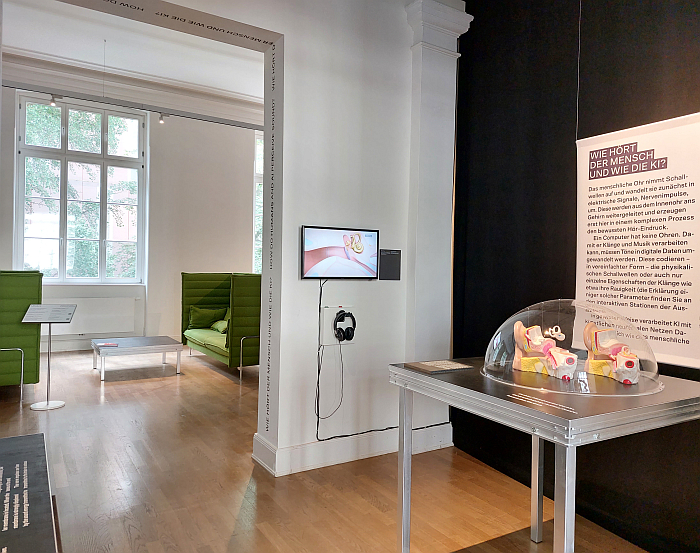
Two Alcove by Ronan and Erwan Bouroullec for Vitra make an excellent location to reflect on AI and music, as seen at Can You Hear It? Music and Artificial Intelligence, Museum für Kunst und Gewerbe, Hamburg
A deceptively bijou showcase whose scope is much wider than its physical presentation, Can You Hear It? presents an awful lot of very technical subjects in readily accessible and digestible formats: it’s succinct bilingual German/English texts being pleasingly free off all to much academese and are ably supported and extended by a very hands on presentation format, or rather an ears on presentation format, featuring as it does an awful lot of interactive listening stations with headphones, headphones we’re not that keen on, certainly not that keen on using, let people use their own, its not as if nobody isn’t permanently attached to their headphones these days.
An ears on, interactive, presentation format, which in its flight case visuals more then implies a touring exhibition awaiting further bookings, booking we’re fairly certain will come, that not only allows one to better appreciate, and thereby better reflect on the potential, and actual, impact of AI on music, or at least the impact of AI on the myriad subjects housed under the roof of Systematic Musicology, nor only allows one to reflect on the validity, and sense, and usefulness and desirability of that impact and where it could take us and our music, and by extrapolation our societies, but also, or rather through enabling such, allows for reflections on relationships with music, on music as an important cultural good, arguably the most important cultural good of any society or community: for as Benny and Björn teach us, “without a song or a dance, what are we?”
What? Honestly? What?
And what will we become without ever new songs and ever new dances? What will we be without the music of the future, for, as we all appreciate,
To live without my music Would be impossible to do.
[Cue the timpano]
Can You Hear It? Music and Artificial Intelligence is scheduled to run at the Museum für Kunst und Gewerbe, Steintorplatz, 20099 Hamburg until Tuesday October 31st.
Full details can be found at www.mkg-hamburg.de
And for all who can’t make it to Hamburg, a large part of the presentation is available online in English and German at https://musicai.uni-hamburg.de
The composing of this post was soundtracked by a wide range of music, some of which/whom we’ve named, and include in a Radio smow playlist by way of supporting reflections on commercial and cultural, and good and bad, in terms of music. And by way of supporting reflections on AI and music. We were going to write some notes on the selection, but we’ve run of space and time. They are however listed in the order they appear in the text and so we”re sure you can work it all out. And yes, it is a very Euro-American centric playlist, but so are we; however we do promsie to try to do a lot better in the future. ……. (All Radio smow playlists can be found on the smowonline spotify page)
More inspiration?
External content is linked here. If you want to see the content once now, click here.
1. Although Stock, Aitken & Waterman wrote they were primarily producers, and as such the industrial, formulaic aspect of their production can, should, must also be compared and contrasted with the likes of, for example, and amongst others, Studio One, Motown, the various K-Pop enterprises or the work of Martin Hannett at Factory Records. Amongst others.
2. As Seneca’s undated 1st Century BCE complaint that “at the present day a library has become as necessary an appendage to a house as a hot and cold bath. I would excuse them straight away if they really were carried away by an excessive zeal for literature; but as it is, these costly works of sacred genius, with all the illustrations that adorn them, are merely bought for display and to serve as wall-furniture”, elegantly reminds us, misusing culture as a form of snobbery is as old as human civilisation, and inarguably is one of those realities we need to move on from…….[Seneca, Minor dialogues, together with the dialogue on clemency. Translated by Aubrey Stewart, Bohn’s Classical Library, G Bell, London, 1889, page 271]
3. Yes, defining what divides us is a component of defining what unites us, and in many regards, yes, ethnology is relevant and informative and useful, but we’d argue it is much better, healthier, meaningfuler etc, to use ethnographic research as a means for exploring common paths taken rather dividing everything up into unhelpful volatile artificial groupings, and then saying you’re X, you’re Y, you’re Z, you’re Y, you’re K, etc…. Can’t we not all just be?
4. Yes, definitions of “good” and “bad” are highly subjective, and highly volatile, but should always be based on an independent, objective assessment of that before you and not a generic organigram, or on what an algorithm tells you.
5. Daft Punk, Giorgio by Moroder, Random Access Memories, 2013 Quote comes at around 5 minutes, just before Daft Punk, inspired by Moroder, do whatever they want
6. Báliant András Varga, Conversations with Iannis Xenakis, Faber & Faber, London, 1996 page 119 Varga’s attempt at using UNIC is briefly described on page 194
7. Le Corbusier, The Modulor: A Harmonious Measure to the Human Scale Universally Applicable to Architecture and Mechanics, Harvard University Press, 1954 page 16
9. Walter Gropius, Brevier für Bauhäusler, believed written in 1924, quoted in Hans Maria Wingler, Das Bauhaus. 1919–1933. Weimar, Dessau, Berlin und die Nachfolge in Chicago seit 1937, page 90 Original German is, “Kunst und Technik eine neue Einheit! Technik braucht nicht Kunst, aber Kunst braucht sehr wohl Technik”
10. Clara Porset, Arte en la industria, Arquitectura México, Nr. 29 Octubre 1949 pages 226-227
11. Rolf Fehlbaum, Ein Projekt mit ungewissen Ausgang, in Uta Brandes; Alexander von Vegesack [Ed], Citizen Office: Ideen und Notizen zu einer neuen Bürowelt, Steidl Verlag, Göttingen, 1994
12. Admittedly not the best example to choose for a judicious and meaningful use of new technology at this point in the (hi)story of human civilisation given ABBA’s hologram residency in London, but Benny and Björn were the ones we used at beginning, and so….
13. While we’re certain an inquisitive creative mind such as Albarn’s is exploring the potential of AI, we’re fairly certain he’d rather that real musicians were involved rather than profiting from the ability to do without actual people. But Gorrilaz is definitely a potential model for the future of commercialised AI music.
Tagged with: Artificial Intelligence, Can You Hear It?, Can You Hear It? Music and Artificial Intelligence, Hamburg, Institute of Systematic Musicology, mkg, Museum für Kunst und Gewerbe, music, Radio smow
